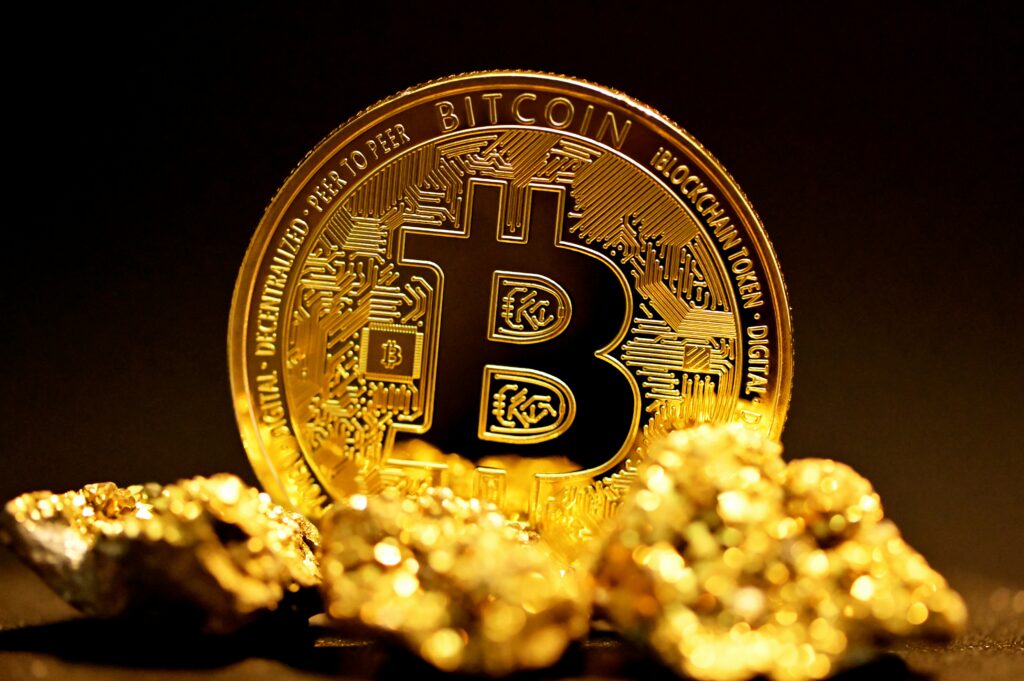Bitcoin: A Guide on the Future of Money
This topic can be controversial at times and there is a lot to break down. Stick with us through this. We are going to break this down into levels with the easier concepts first. So, what is Bitcoin?

Level 1: What is Bitcoin, and Why Should You Care?
You’ve probably heard people talk about Bitcoin like it’s either the future of money or a scam cooked up by internet nerds. Maybe you’ve seen a headline about it hitting $60,000 one year and crashing to $20,000 the next.
So what is Bitcoin? And why do some people swear it’s going to replace the dollar while others call it a bubble waiting to pop?
Lets strip away the hype and get to the facts.
At its core, Bitcoin is digital money – but unlike dollars in your bank account, it’s decentralized. That means no banks, no governments, and no middlemen telling you what you can or can’t do with your own money.
Instead of a bank keeping track of your balance, Bitcoin transactions are recorded on something called the blockchain – a public ledger that can’t be changed, hacked, or controlled by any one person. Every Bitcoin transaction is verified by thousands of computers around the world, making it one of the most secure financial systems ever created.
We urge you to also explore Bitcoin.org’s official guide for a beginner-friendly explanation of how the system works under the hood.
Level 2: How Do You Actually Buy and Use Bitcoin?
So now you know what Bitcoin is. But how do you actually buy it and use it?
The easiest way to get started is through a crypto exchange, which works like a stock market for Bitcoin. Some of the most beginner-friendly exchanges include Coinbase, Binance, and Kraken.
Once you buy Bitcoin, you can store it in two ways: leave it on the exchange (easy, but riskier), or move it to a private wallet (safer, but requires setup).
But Bitcoin isn’t just for investing—it’s also real money. Here’s how people actually use Bitcoin today: Buying Goods and Services – Major companies like Microsoft, Overstock, and Newegg accept Bitcoin for payments. Sending Money Internationally – Bitcoin makes it cheaper and faster to send money abroad compared to traditional bank wires. Earning Interest – Platforms like BlockFi and Celsius let you earn interest on your Bitcoin holdings (though always research risks).
Bitcoin is slowly becoming more mainstream, and as adoption grows, using it for everyday payments will become even easier.
Level 3: The Wild World of Bitcoin Investing
At this point, you might be wondering: Should I actually buy Bitcoin, or is it too risky?
Bitcoin has been called “digital gold” because, like gold, there’s a limited supply—only 21 million will ever exist. That scarcity makes Bitcoin an attractive store of value, but also extremely volatile.
How Much Would You Have If You Invested $1,000 in Bitcoin 10 Years Ago? In 2014, Bitcoin was trading at around $500 per coin. A $1,000 investment back then would have bought 2 Bitcoin. Today, at an average price of $90,000 per Bitcoin, your $1,000 investment would be worth $180,000!

Now, past performance doesn’t guarantee future returns, but Bitcoin’s growth has outpaced nearly every other asset over the last decade.
If you’re thinking of investing, keep these in mind: Long-Term vs. Short-Term Investing: Some people buy Bitcoin and hold for years (HODLers), while others trade it daily for quick gains. Volatility: Bitcoin’s price can swing 10% in a day, so don’t invest money you can’t afford to lose. Security Matters: Unlike stocks, if you lose your Bitcoin password, your money is gone forever.
Some investors allocate 1-5% of their portfolio to Bitcoin as a hedge against inflation and the traditional banking system.
Level 4: Advanced Bitcoin - Security, Mining, and the Lightning Network
Okay, now we’re getting into the serious stuff. If you’ve made it this far, congrats—you’re no longer a Bitcoin beginner.
Bitcoin Storage & Cold Wallets: Unlike bank accounts, Bitcoin storage is your responsibility. There are two main types of wallets: Hot Wallets (Online & App-Based) – Easier to use but more vulnerable to hacking. Examples: Trust Wallet, MetaMask. Cold Wallets (Offline Storage) – The safest way to store Bitcoin long-term. These include hardware wallets like Ledger and Trezor that keep your Bitcoin completely offline.
Cold storage = ultimate security. If an exchange gets hacked, you won’t lose a dime if your Bitcoin is stored on a hardware wallet.
The Lightning Network: One of Bitcoin’s biggest criticisms is that it’s too slow and expensive for everyday transactions. The Lightning Network fixes that by enabling instant, low-cost Bitcoin payments. It’s still growing but could make Bitcoin usable for buying coffee or paying rent.
Bitcoin Mining: Every Bitcoin transaction is verified by miners, who use powerful computers to solve complex math problems and secure the network. In return, they earn new Bitcoin. Mining used to be profitable for regular people, but now it requires specialized hardware and massive amounts of electricity.
Bitcoin as the Future of Money: Some countries (like El Salvador) already accept Bitcoin as legal currency, and major corporations are starting to invest in it. Will Bitcoin replace traditional money? Maybe. But even if it doesn’t, it’s already changing the financial system in ways that can’t be ignored.
Final Thoughts: Should You Buy Bitcoin?
Bitcoin is not a get-rich-quick scheme, but it is one of the most disruptive financial innovations of our time. Whether you see it as a store of value, an investment, or the future of money, it’s hard to ignore its impact.
If you’re just getting started, the key is to educate yourself, invest responsibly, and always prioritize security.
